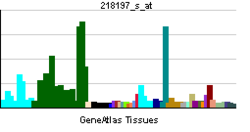- OXR1
-
Oxidation resistance 1 Identifiers Symbols OXR1; FLJ10125; FLJ38829; FLJ40849; FLJ41673; FLJ42450; FLJ45656 External IDs OMIM: 605609 MGI: 2179326 HomoloGene: 24993 GeneCards: OXR1 Gene Gene Ontology Molecular function • molecular_function Cellular component • cellular_component
• nucleolus
• mitochondrionBiological process • response to oxidative stress
• cell wall macromolecule catabolic processSources: Amigo / QuickGO RNA expression pattern 
More reference expression data Orthologs Species Human Mouse Entrez 55074 170719 Ensembl ENSG00000164830 ENSMUSG00000022307 UniProt Q8N573 n/a RefSeq (mRNA) NM_001198532.1 NM_130885 RefSeq (protein) NP_001185461.1 NP_570955 Location (UCSC) Chr 8:
107.28 – 107.76 MbChr 15:
41.28 – 41.69 MbPubMed search [1] [2] Oxidation resistance protein 1 is a protein that in humans is encoded by the OXR1 gene.[1][2]
References
- ^ Volkert MR, Elliott NA, Housman DE (Jan 2001). "Functional genomics reveals a family of eukaryotic oxidation protection genes". Proc Natl Acad Sci U S A 97 (26): 14530–5. doi:10.1073/pnas.260495897. PMC 18953. PMID 11114193. http://www.pubmedcentral.nih.gov/articlerender.fcgi?tool=pmcentrez&artid=18953.
- ^ "Entrez Gene: OXR1 oxidation resistance 1". http://www.ncbi.nlm.nih.gov/sites/entrez?Db=gene&Cmd=ShowDetailView&TermToSearch=55074.
Further reading
- Ohira M, Morohashi A, Nakamura Y et al. (2003). "Neuroblastoma oligo-capping cDNA project: toward the understanding of the genesis and biology of neuroblastoma". Cancer Lett. 197 (1–2): 63–8. doi:10.1016/S0304-3835(03)00085-5. PMID 12880961.
- Durand M, Kolpak A, Farrell T et al. (2007). "The OXR domain defines a conserved family of eukaryotic oxidation resistance proteins". BMC Cell Biol. 8: 13. doi:10.1186/1471-2121-8-13. PMC 1847813. PMID 17391516. http://www.pubmedcentral.nih.gov/articlerender.fcgi?tool=pmcentrez&artid=1847813.
- Olsen JV, Blagoev B, Gnad F et al. (2006). "Global, in vivo, and site-specific phosphorylation dynamics in signaling networks". Cell 127 (3): 635–48. doi:10.1016/j.cell.2006.09.026. PMID 17081983.
- Gerhard DS, Wagner L, Feingold EA et al. (2004). "The Status, Quality, and Expansion of the NIH Full-Length cDNA Project: The Mammalian Gene Collection (MGC)". Genome Res. 14 (10B): 2121–7. doi:10.1101/gr.2596504. PMC 528928. PMID 15489334. http://www.pubmedcentral.nih.gov/articlerender.fcgi?tool=pmcentrez&artid=528928.
- Elliott NA, Volkert MR (2004). "Stress Induction and Mitochondrial Localization of Oxr1 Proteins in Yeast and Humans". Mol. Cell. Biol. 24 (8): 3180–7. doi:10.1128/MCB.24.8.3180-3187.2004. PMC 381681. PMID 15060142. http://www.pubmedcentral.nih.gov/articlerender.fcgi?tool=pmcentrez&artid=381681.
- Ota T, Suzuki Y, Nishikawa T et al. (2004). "Complete sequencing and characterization of 21,243 full-length human cDNAs". Nat. Genet. 36 (1): 40–5. doi:10.1038/ng1285. PMID 14702039.
- Strausberg RL, Feingold EA, Grouse LH et al. (2003). "Generation and initial analysis of more than 15,000 full-length human and mouse cDNA sequences". Proc. Natl. Acad. Sci. U.S.A. 99 (26): 16899–903. doi:10.1073/pnas.242603899. PMC 139241. PMID 12477932. http://www.pubmedcentral.nih.gov/articlerender.fcgi?tool=pmcentrez&artid=139241.
Categories:- Human proteins
- Chromosome 8 gene stubs
Wikimedia Foundation. 2010.
